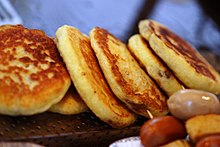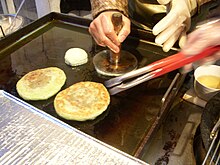 | |
| Type | Pancake |
|---|---|
| Place of origin | Korea |
| Created by | Qing merchants in Korea |
| Main ingredients | Dough: wheat flour, water, milk, sugar, yeast Filling: brown sugar, honey, peanuts, cinnamon |
| Hotteok | |
| Hangul | 호떡 |
|---|---|
| Hanja | 胡떡 |
| Revised Romanization | hotteok |
| McCune–Reischauer | hottŏk |
| IPA | Korean pronunciation: [ho.t͈ʌk̚] |
Hotteok (Korean: 호떡, pronounced [ho.t͈ʌk̚]), sometimes called hoeddeok, is a type of filled pancake known as a popular street food in South Korea. It originated in Qing dynasty, and was first brought into Joseon Korea during the 19th century.
Preparation

The dough for hotteok is made from wheat flour, water, milk, sugar, and yeast. The dough is allowed to rise for several hours. Handful-sized balls of this stiff dough are filled with a sweet mixture, which may contain brown sugar, honey, chopped peanuts, and cinnamon. The filled dough is then placed on a greased griddle, and pressed flat into a large circle, this is done with a stainless steel circle and wooden handle as it cooks.
In South Korea, ready-made dry hotteok mix is commercially available in plastic packages. The mix also comes with a filling consisting of brown sugar and ground peanuts or sesame seeds.
History
Hotteok is also closely related to the Silk Road as foods related to wheat flour originated. It is generally believed that the Qing merchants who immigrated to and settled down in Korea around the late 19th century made and sold hotteok at cheap prices, which helped spread the dish throughout Korea. It is said that Qing merchants who entered Korea during the Imo Incident did not return to their homeland even after their country was destroyed, but opened restaurants and sold food to make a living, and one of them was hotteok.
Unlike other Korean pancakes, which often contain savory meat fillings, hotteoks usually have been stuffed with sweet fillings, to suit Koreans' culinary tastes.
Varieties

The types of hotteok have been changing continuously although many favour the traditional cinnamon and peanut filling. Many variations have developed since the early 21st century, such as green tea hotteok, pink bokbunja hotteok, corn hotteok, pizza hotteok and more. Along with that many vendors now sell yachae-hotteok made with japchae and vegetables. Commercially produced hotteok products are developed and sold by companies such as Samyang, Ottogi, and CJ. Such products are designed to be cooked at home.
Nutrition
Hotteok is usually eaten during the winter season. Due to its high sugar content, a single hotteok may have as many as 230 calories.
Phrases using hotteok
Koreans say "The hotteok store is burning (호떡집에 불났다.)" to refer to noisy situations. It is believed that the phrase originated from the thought of Qing merchants arguing over the reason of a fire at their hotteok stall.
See also
- Korean Chinese cuisine
- Hoppang
- Bungeoppang
- List of Korean desserts
- Street food in South Korea
- List of pancakes
- List of stuffed dishes
References
- ^ (in Korean) 호떡, 가난한 쿨리의 가장 먹기 편한 음식, The Hankyoreh, 2012-04-27. Retrieved 2017-07-11.
- ^ Krishna, Priya (4 February 2022). "The Warm, Sticky-Sweet Resurgence of Hotteok". The New York Times. Retrieved 28 February 2022.
The origin of Hotteok is Chinese traditional folk snack-sugar cake (different regions in China have different types of sugar cake)and it was brought to the country by Chinese immigrants in the late 19th century, as an adaptation of bing.
- (in Korean) Hotteok Archived 2011-07-14 at the Wayback Machine at The National Institute of the Korean Language Dictionary
- (in Korean) Recipe for hotteok at Naver kitchen
- (in Korean) Snack mix popularity on the rise, Yonhap News, 2010-01-07. Retrieved 2010-06-27.
- ^ (in Korean) Hotteok, Kyunghyang News, 2003-11-20. Retrieved 2010-06-27.
- photo
- Maangchi. "Hotteok filled with vegetables & noodles (Yachae-hotteok: 야채호떡) recipe by Maangchi". www.maangchi.com. Retrieved 2021-11-13.
- (in Korean) Winter snacks, Kukinews, 2007-01-07.
External links
- Two variations of hotteok
- Hotteok recipe
- Hotteok recipe with video
- Article about the origin of Hotteok and Hobbang (in Korean)